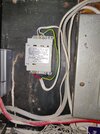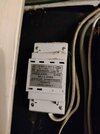I want to install Nest Hello doorbell and looking at my current setup there's the earth wire going from the power supply below the transformer into the top between the bell cables. Is that ok?
When i get a new transformer would I do the same or should the earth wire go somewhere else?
Pic attached.
When i get a new transformer would I do the same or should the earth wire go somewhere else?
Pic attached.





